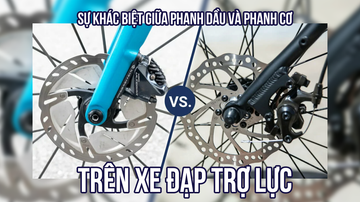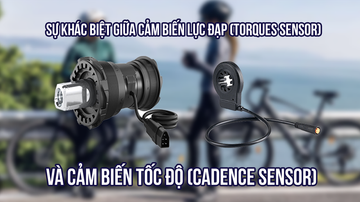
Rear axle engine vs Mid shaft motor
Your pros and cons
When you choose a power bike for yourself, the variety of models is always a headache. However, if you get an overview of the current power-assisted bicycle market, you will notice that the bike lines are divided into 2 major lines. These are mid-axle motor power-assisted bicycles and rear-axle motor electric bicycles. The difference between these two models comes from the electric motor part of the car itself. As an important part that plays a major role in the operation and performance of the vehicle, the engine is always the first thing users care about. Today, I will analyze the similarities and differences between the two types of engines. I'll compare them on the following criteria: Performance, Maintenance, Cost, range, handling and more.
- Engine cost
This is the criterion I choose to do first because the price of a car greatly affects the choice of buyers. The ADO D30C engine costs less than $1000 for a genuine engine set. Or like cheaper products, like the T14, the engine price is only $200-250. It is really suitable and anyone can buy themselves an electric bike.

See also: Bicycle ADO A26S VEHICLE
- Performance

On a vehicle with a mid-axle engine, the engine assembly is usually located in the bottom bracket, and in the middle of the vehicle, directly connected to the crankshaft. Therefore, the mid-axle motor is firmly attached to the chassis.
Similar to motorcycles, the mid-axle motor does not drive the wheels directly. Through the chain, mechanical energy is converted into kinetic energy by rotating the chain. Basically, the mid-shaft motor makes it easier for you to pedal when pedaling. Therefore, most electric vehicles using mid-axle motors only have electric power steering. Throttling with a mid shaft motor is very difficult as that will cause friction between the sensor and crank, reducing life and efficiency.
However, one advantage of the mid-shaft motor is that it can rapidly increase the power of the engine. For example, when you downshift, the engine turns the cranks more easily. This allows you to easily power up when riding on steep hills. As you increase gears, the engine has to work harder to turn the cranks. The mechanical advantage of gears allows you to reach higher speeds. You can also use gears to keep the engine at the ideal rpm. Using discs and cassettes allows you to ride faster, more efficiently and on a variety of terrains.

The mid-shaft motor has a built-in power steering sensor. Most mid-drive e-bikes come with a torque sensor. This sensor measures the amount of force you put on the pedal and then transmits this information to the bike's controls. The control unit then adjusts the support level based on that measurement. As you pedal harder, the motor delivers more power. When you pedal more gently, the engine delivers less power. Instead, some mid-drive e-bikes use a cadence sensor. I will talk more about the cadence sensor in the next section.
Most mid-drive e-bikes only offer pedal support. They don't have gas. This means you have to pedal for the engine to provide power. There are exceptions. Mid-shaft motors are a relatively new technology. Mid-axle e-bikes have only been popular since around 2010. Expensive high-end e-bikes tend to come with mid-shaft motors.

The electric bike rear axle motor has an electric motor built into the rear wheel. The rear axle motor is used in place of a standard hub unit. Usually, the engine is installed at the rear of the vehicle. The rear axle motor provides power directly to the wheel in which it is integrated. In other words, it transmits torque directly to the wheel. It works completely separate from the bike's drivetrain. A rear axle motor is not affected by gear shifts. By far, the hub motor is the most common type of electric power assist bicycle motor.
There are two types of hub motors: geared and gearless. Gearless hub motors have no moving parts other than a hub bearing. They are mechanically simple. Gearless motors are common on low-end e-bikes. Gearless hub motors are also known as direct drive.
Gear shaft motors use internal planetary gears to reduce the number of revolutions per minute of the motor. The gears allow a smaller motor to generate more power, improving their efficiency. These engines are more complex. They are common on high-end power-assisted electric bicycles such as the ADO E-bike.

See also: ADO DECE 300 Lite power-assisted bicycle
Most rear axle motorized e-bikes come with a cadence sensor-based pedal assist system. The cadence sensor will measure if you are pedaling. Some bikes have a controller that also measures your pedaling speed.
When you start pedaling, the sensor sends a signal to the bike's controls. The controller then turns on the rear axle motor. When you stop pedaling, the sensor will signal the controller and the engine will turn off. Instead, more advanced rear-axle motorized e-bikes come with a torque-sensing pedal assist system.
Most hub motors provide a constant level of power when you pedal. The motor is on or off. Some center-drive ebikes allow you to adjust the level of pedal support. There can be 3-5 support settings. When driving at level 1, the engine provides minimal assistance. At level 5, the engine is operating at full capacity. On higher end models, the system can automatically adjust based on your beat. When you start pedaling, the engine runs at full power. When you reach the span threshold, the power will decrease.
Some electric bicycles with rear axle motors also feature throttle acceleration. The throttle is mounted on the handlebar. You just need to turn your hand to control the speed of the motor. When using the gas, you don't have to pedal. That is the biggest advantage of the rear-axle motor over the mid-axle motor. The fact that the bike is always ready to move even when you are not pedaling is a great thing. Especially in a country with a tropical monsoon climate like Vietnam. Imagine cycling in the summer, only 1-2 hours will make you tired, then using the throttle function to recover is a great idea, isn't it?

The main difference between mid- and rear-axle electric bicycles is the position of the motor on the bike. The rear axle motor is located in the center of the frame, between the pedals. The rear axle drive motor is integrated into the rear wheel of the vehicle.
Another important difference is how the motor delivers power. The mid-axle motor powers the bike through the drivetrain, just as you would while pedaling. They apply torque to the cranks. This turns the chain and rear wheel. The rear axle motor provides power directly to the wheels in which they are built. They transmit torque to the wheel.
Pedal assist systems may also vary. Most mid-axle e-bikes have a torque sensor to measure your pedaling force. This allows the system to change the level of pedal support based on how much you pedal. Most rear axle motorized e-bikes come with a cadence sensor that measures if you're pedaling. The motor provides a constant level of power as you pedal.
The bike frames are also different. Commonly used mid-axle e-bikes require a special frame with the motor integrated into the bottom rack area. The frames are designed to fit a specific engine. Power-assisted electric bicycles are more diverse with many designs to suit the tastes of buyers. The only fixed part is the wheel with the built-in motor.
An important difference is cost. Mid-axle motor e-bikes are significantly more expensive than rear-axle motor models.
The ADO E-Bike is a solid companion in urban living. We create products that provide a great driving experience on complex traffic conditions such as bumpy, rocky and uphill. All ADO products are designed to be environmentally friendly and comply with environmental guidelines.

![[Giới thiệu đại lý] Xe đạp trợ lực Bắc Ninh: Chất Lượng Đỉnh Cao, Dịch Vụ Xuất Sắc!](http://adoebike.vn/cdn/shop/articles/z5055148522302_2b02a598456435425f3201195840d97a.jpg?v=1705315901&width=360)


